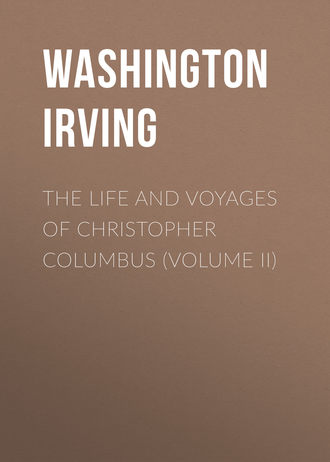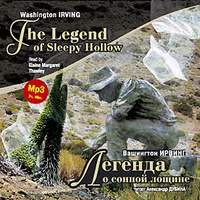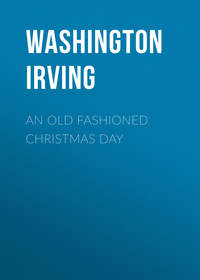 полная версия
полная версияThe Life and Voyages of Christopher Columbus (Volume II)
281
Senarega, Muratori, tom. 24.
282
Foglieta, Elog. Clar. Ligur.
283
Grineus, Nov. Orb.
284
"Item. Mando el dicho Don Diego mi hijo, á la persona que heredare el dicho mayorazgo, que tenga y sostenga siempre en la ciudad de Genova una persona de nuestro linage que tenga alli casa é muger, é le ordene renta con que pueda vivir honestamente, como persona tan llegada á nuestro linage, y haga pie y raiz en la dicha ciudad como natural della, porque podrá baber de la dicha ciudad ayuda e favor en las cosas del menester suyo, pues que della sali y en ella naci."
285
Hist. del Almirante, cap. 1.
286
Duke of Calabria was a title of the heir apparent to the crown of Naples.
287
Colenuccio, Hist. Nap., lib. vii. cap. 17.
288
Zurita, Anales de Aragon, lib. xx. cap. 64.
289
Obras de Gareta de Resende, cap. 58, Avora, 1554.
290
Marco Antonio Coccio, better known under the name of Sabellicus, a cognomen which he adopted on being crowned poet in the pedantic academy of Pomponius Lætus. He was a contemporary of Columbus, and makes brief mention of his discoveries in the eighth book of the tenth Ennead of his universal history. By some writers he is called the Livy of his time; others accuse him of being full of misrepresentations in favor of Venice. The older Scaliger charges him with venality, and with being swayed by Venetian gold.
291
Bandini vita d'Amerigo Vespucci.
292
Cosm. Munst., p. 1108.
293
These particulars are from manuscript memoranda, extracted from the royal archives, by the late accurate historian Muñoz.
294
Bartolozzi, Recherche Historico. Firenze, 1789.
295
Panzer, tom. vi. p. 33, apud Esame Critico, p. 88, Antazione 1.
296
This rare book, in the possession of O. Rich, Esq., is believed to be the oldest printed collection of voyages extant. It has not the pages numbered; the sheets are merely marked with a letter of the alphabet at the foot of each eighth page – It contains the earliest account of the voyages of Columbus, from his first departure until his arrival at Cadiz in chains. The letter of Vespucci to Lorenzo de Medici occupies the fifth book of this little volume. It is stated to have been originally written in Spanish, and translated into Italian by a person of the name of Jocondo. An earlier edition is stated to have been printed in Venice by Alberto Vercellese, in 1504. The author is said to have been Angelo Trivigiani, secretary to the Venetian ambassador in Spain. This Trivigiani appears to have collected many of the particulars of the voyages of Columbus from the manuscript decades of Peter Martyr, who erroneously lays the charge of the plagiarism to Aloysius Cadamosto, whose voyages are inserted in the same collection. The book was entitled, "Libretto di tutta la navigazione del Re de Espagna, delle Isole e terreni nuovamente trovati."
297
Letter of Vespucci to Soderini or Renato – Edit. of Canovai.
298
Navarrete, Colec. Viag., tom. i. p. 351.
299
Peter Martyr, decad. iii. lib. v. Eden's English trans.
300
En este viage que este dicho testigo hizo trujo consigo a Juan de la Cosa, piloto, e Morego Vespuche, e otros pilotos.
301
Per la necessitá del mantenimento fummo all' Isola d'Antiglia (Hispaniola) che é questa che descoperse Cristoval Colombo piú anni fa, dove facemmo molto mantenimento, e stemmo due mesi e 17 giorni; dove passammo moti pericoli e travagli con li medesimi christiani que in questa isola stavanno col Colombo (credo per invidia). Letter of Vespucci. – Edit. of Canovai.
302
Preguntado como lo sabe; dijo – que lo sabe porque vió este testigo la figura que el dicho Almirante al dicho tiempo embió á Castilla al Rey e Reyna, nuestros Señores, de lo que habia descubierto, y porque este testigo luego vino á descubrir y halló que era verdad lo que dicho tiene que el dicho Almirante descubrió MS. Process of D. Diego Colon, Pregunta 2.
303
Este testigo escrivió úna carta que el Almirante escriviera al Rey a Reyna N. N. S. S. haciendo les saber las perlas e cosas que habia hallado, y le embió señalado con la dieba carta, en una carta de marear, los rumbos y víentos por donde habia llegado á la Paria, e que este testigo oyó decir como pr. aquella carte se habían hecho otras e por ellas habian venido Pedro Alonzo Merino (Niño) e Ojeda e otros que despues han ido á aquellas partes. Process of D. Diego Colon, Pregunta 9.
304
Idem, Pregunta 10.
305
Que en todos los viages qne algunos hicieron descubriendo en la dicha tierra, ivan personas que ovieron navegado con el dicho Almirante, y a ellos mostró muchas cosas de marear, y ellos por imitacion é industria del dicho Almirante las aprendian y aprendieron, e seguendo ag°. que el dicho Almirante les habia mostrado, hicieron los viages que desenbrieron en la Tierra Firma. Process, Pregunta 10.
306
The first suggestion of the name appears to have been in the Latin work already cited, published in St. Diez, in Lorraine, in 1507, in which was inserted the letter of Vespucci to king René. The author, after speaking of the other three parts of the world, Asia, Africa, and Europe, recommends that the fourth ehall be called Amerigo, or America, after Vespucci, whom he imagined its discoverer.
Note to the Revised Edition, 1848.– Humboldt, in his Examen Critique, published in Paris, in 1837, says: "I have been so happy as to discover, very recently, the name and the literary relations of the mysterious personage who (in 1507) was the first to propose the name of America to designate the new continent, and who concealed himself under the Grecianized name of Hylacomylas." He then, by a long and ingenious investigation, shows that the real name of this personage was Martin Waldseemüller, of Fribourg, an eminent cosmographer, patronized by René, duke of Lorraine; who no doubt put in his hands the letter received by him from Amerigo Vespucci. The geographical works of Waldseemüller, under the assumed name of Hylacomylas, had a wide circulation, went through repeated editions, and propagated the use of the name America throughout the world. There is no reason to suppose that this application of the name was in any wise suggested by Amerigo Vespucci. It appears to have been entirely gratuitous on the part of Waldseemüller.
307
An instance of these errors may be cited in the edition of the letter of Amerigo Vespucci to king René, inserted by Grinæus in his Novus Orbis, in 1532. In this Vespucci is made to state that he sailed from Cadiz May 20, MCCCCXCVII. (1497,) that he was eighteen months absent, and returned to Cadiz October 15, MCCCCXCIX. (1499,) which would constitute an absence of 29 months. He states his departure from Cadiz, on his second voyage, Sunday, May 11th, MCCCCLXXXIX. (1489,) which would have made his second voyage precede his first by eight years. If we substitute 1499 for 1489, the departure on his second voyage would still precede his return from his first by five months. Canovai, in his edition, has altered the date of the first return to 1498, to limit the voyage to eighteen months.
308
Gomara, Hist. Ind., cap. 14.
309
Navigatio Christophori Columbi, Madrignano Interprete. It is contained in a collection of voyages called Novus Orbis Regionum, edition of 1555, but was originally published in Italian as written by Montalbodo Francanzano (or Francapano de Montaldo), in a collection of voyages entitled Nuovo Mundo, in Vicenza, 1507.
310
Girolamo Benzoni, Hist, del Nuevo Mundo, lib. i. fo. 12. In Venetia, 1572.
311
Padre Joseph de Acosta, Hist. Ind., lib. i. cap. 19.
312
Juan de Mariana, Hist. Espana, lib. xxvi. cap. 3.
313
Herrera, Hist. Ind., decad. ii. lib. iii. cap. 1.
314
Commentarios de los Incas, Lib. i. cap. 3.
315
Names of historians who either adopted this story in detail, or the charge against Columbus, drawn from it.
Bernardo Aldrete, Antiguedad de España, lib. iv. cap. 17, p. 567.
Roderigo Caro, Antiguedad, lib. iii. cap. 76.
Juan de Solorzano, Ind. Jure, tom. i. lib. i. cap. 5.
Fernando Pizarro, Varones Ilust. del Nuevo Mundo, cap. 2.
Agostino Torniel, Annal. Sacr., tom. i. ann. Mund., 1931, No. 48.
Pet. Damarez or De Mariz, Dial. iv. de Var. Hist., cap. 4.
Gregorio Garcia, Orig. de los Indies, lib. i. cap. 4, 1.
Juan de Torquemada, Monarch. Ind., lib. xviii. cap. 1.
John Baptiste Riccioli, Geograf. Reform., lib. iii.
To this list of old authors may be added many others of more recent date.
316
"Francisco Lopez de Gomara, Presbitero, Sevillano, escribio con elegante estilo acerca de las cosas de las Indies, pero dexandose llevar de falsas narraciones." Hijos de Sevilla, Numero ii. p. 42, Let. F. The same is stated in Bibliotheca Hispaña Nova, lib. i. p. 437. "El Francisco Lopez de Gomara escrivio tantos borrones é cosas que no son verdaderas, de que ha hecho mucho daño a muchos escritores e coronistas, que despues del Gomara han escrito en las cosas de la Nueva España … es porque les ha hecho errar el Gomara." Bernal Diaz del Castillo, Hist. de la Conquest de la Nueva España, Fin de cap. 13.
"Tenía Gomara doctrina y estilo … per empleose en ordinar sin discernimiento lo que halló escrito por sus antecesores, y dió credito á petrañas no solo falsas sino inverisimiles." Juan Bautista Muñoz, Hist. N. Mundo, Prologo, p 18.
317
Vasconcelos, lib. 4.
318
Murr, Notice sur M. Behaim.
319
Barros, decad. i. lib. ii. cap. 1. Lisbon, 1552.
320
Investigations Historicas, Madrid, 1794.
321
Cladera, Investig. Hist., p. 115.
322
Forster's Northern Voyages, book ii. chap. 2.
323
This account is taken from Hakluyt, vol. iii. p. 123. The passage about gold and other metals is not to be found in the original Italian of Ramusio, (tom. ii. p. 23,) and is probably an interpolation.
324
Hakluyt, Collect., vol. iii. p. 127.
325
Malte-Brun, Hist, de Geog., tom. i. lib. xvii.
326
Idem, Geog. Unirerselle, tom. xiv. Note sur la decouverte de l'Amerique.
327
Gosselin, Recherches sur la Geographic des Anciens, tom. i. p. 162, &c.
328
Memoirs de l'Acad. des Inscript., tom. xxvi.
329
Capmany, Questiones Criticas, Quest. 6.
330
Archives de Ind. en Sevilla.
331
Capmany, Queat. Crit.
332
The author of this work is indebted for this able examination of the route of Columbus to an officer of the navy of the United States, whose name he regrets the not being at liberty to mention. He has been greatly benefited, in various parts of this history, by nautical information from the same intelligent source.
333
Herrera, Hist. Ind., decad. i. lib. ix. cap. 10.
334
In the first chapter of Herrera's description of the Indies, appended to his history, is another scale of the Bahama islands, which corroborates the above. It begins at the opposite end, at the N. W., and runs down to the S.E. It is thought unnecessary to cite it particularly.
335
See Caballero Pesos y Medidas. J. B. Say. Economic Politique.
336
In preparing the first edition of this work for the press the author had not the benefit of the English translation of Marco Polo, published a few years since, with admirable commentaries, by William Marsden, F. R. S. He availed himself, principally, of an Italian version in the Venetian edition of Ramusio (1606), the French translation by Bergeron, and an old and very incorrect Spanish translation. Having since procured the work of Mr. Marsden, he has made considerable alterations in these notices of Marco Polo.
337
Ramusio, tom. iii.
338
Bergeron, by blunder in the translation from the original Latin, has stated that the Khan sent 40,000 men to escort them. This has drawn the ire of the critics upon Marco Polo, who have cited it as one of his monstrous exaggerations.
339
Hist. des Voyages, tom, xxvii. lib. iv. cap. 3. Paris, 1549.
340
Ramusio, vol. ii. p. 17.
341
Mr. Marsden, who has inspected a splendid fac-simile of this map preserved in the British Museum, objects even to the fundamental part of it: "where," he observes, "situations are given to places that seem quite inconsistent with the descriptions in the travels, and cannot be attributed to their author, although inserted on the supposed authority of his writings." Marsden's M. Polo, Introd., p. xlii.
342
Hist, des Voyages, torn. xl. lib. xi. ch, 4.
343
Another blunder in translation has drawn upon Marco Polo the indignation of George Hornius, who (in his Origin of America, IV. 3) exclaims, "Who can believe all that, he says of the city of Quinsai? as, for example, that it has stone bridges twelve thousand miles high!" &c. It is probable that many of the exaggerations in the accounts of Marco Polo are in fact the errors of his translators.
Mandeville, speaking of this same city, which he calls Causai, says it is built on the sea like Venice, and has twelve hundred bridges.
344
Sir George Staunton mentions this lake as being a beautiful sheet of water, about three or four miles in diameter; its margin ornamented with houses and gardens of Mandarines, together with temples, monasteries for the priests of Fo, and an imperial palace.
345
Supposed to be those islands collectively called Japan. They are named by the Chinese Ge-pen; the terminating syllable go, added by Marco Polo, is supposed to be the Chinese word kue, signifying kingdom, which is commonly annexed to the names of foreign countries. As the distance of the nearest part of the southern island from the coast of China near Ning-po is not more than five hundred Italian miles, Mr. Marsden supposes Marco Polo, in stating it to be 1500, means Chinese miles or li, which are in the proportion of somewhat more than one-third of the former.
346
Aristot., 2 Met. cap. 5.
347
Pliny, lib. i. cap. 61.
348
Feyjoo, Theatre Critico, tom. iv. d. 10, § 29.
349
Lib. iv. de la Chancelaria del Key Dn. Juan II, fol. 101.
350
Torre do Tombo. Lib. das Ylhas, f. 119.
351
Fr. Gregorio Garcia, Origen de los Indios, lib. i. cap. 9.
352
Sigeberto, Epist. ad Tietmar. Abbat.
353
Nuñez de la l'ena. Conquist de la Gran Canaria.
354
Ptolemy, lib. iv. tom. iv.
355
Fr. D. Philipo, lib. viii. fol. 25.
356
Hist. Isl. Can., lib. i. cap. 28.
357
Nuñez de la Pena, lib. i. cap. 1. Viera, Hist Isl. Can., tom. i. cap. 28.
358
Nuñez, Conquista le Gran Canaria. Viera, Hist. &c.
359
Viera, Hist. Isl. Can., tom. i. cap. 28.
360
Idem.
361
Viera, Hist. Isl. Can., tom. i. cap. 28.
362
Viera, ubi sup.
363
Theatro Critico, tom. iv. d. x.
364
Hist. del Almirante, cap. 10.
365
Torquemada, Monarquia Indiana, lib. iv. cap. 4. Origen de los Indios por Fr. Gregorio Garcia, lib. iv. cap. 20.
366
Barros, Asia, decad. i. lib. i. cap. 3.
367
Navarrete, Colec. Viag., tom. i. Introd. p. lxx.
368
T. A. Llorente, Oeuvres de Las Casas, p. xi. Paris, 1822.
369
Herrera clearly states this as an expedient adopted when others failed. "Bartolomé de las Casas, viendo que sus conceptos hallaban en todas partes dificultad, i que las opiniones que tenla, por mucha familiaridad que havia seguido i gran credito con el gran Canciller, no podian haber efecto, se volvio a otros expedientes, &c." – Decad. ii. lib. ii. cap. 2.
370
Herrera, Hist. Ind., decad. iii. lib. ii. cap. 4.
371
Idem, decad. ii. lib. ii. cap. 20.
372
Idem, decad. ii. lib. iii. cap. 8.
373
1 Herrera, d. i. lib. vi. cap. 20.
374
Idem, d. i. lib. viii. cap. 9.
375
Idem, d. i. lib. ix. cap. 5.
376
Robertson, Hist. America, p. 3.
377
Porque como iban faltando los Indios i se conocia que un negro trabajaba, mas que quatro, por lo qual habia gran dem anda de ellos, parccia que se podia poner algun tributo en la saca, de que resultaria provecho á la Rl. Hacienda. Herrera, decad. ii. lib. ii. cap. 8.
378
De Marsolier, Hist. du Ministere Cardinal Ximenes, lib. vi. Toulouse, 1694.
379
In this notice the author has occasionally availed himself of the interesting memoir of Mon. J. A. Idorente, prefixed to his collection of the works of Las Casas, collating it with the history of Herrera, from which its facts are principally derived.
380
Navarrete, Colec. de Viag., tom. i. p. lxxv.
381
Opus Epist. P. Martyris Anglerii, Epist. 131.
382
Opus Epist. P. Martyris Anglerii, Epist. 134.
383
Opus Epist. P. Martyrin Anglerii, Epist. 135.
384
Idem, Epist. 141.
385
Idem, Epist. 147.
386
Cura de los Palacios, cap. 7.
387
Bibliotheca Pinello.
388
Herrera, decad ii. lib. ii. cap. 3.
389
Idem, decad. iii. lib. iv. cap. 3.
390
Herrera, Hist. Ind., decad. iii. lib. i. cap. 15.
391
Idem, decad. iii. lib. iv. cap. 3.
392
Salazar, Conq. de Mexico, lib. i. cap. 2.
393
Herrera, Hist. Ind., decad. iii. lib. i. cap. 1.
394
Idem, decad. iii. lib. iv. cap. 3.
395
Gosselin, Recherches sur la Geog. des Anciens, tom. i.
396
Feyjoo, Theatro Critico, lib. vii. § 2.
397
Herodot., lib. iii. Virg. Georg. i. Pomp. Mela, lib. iii. cap. 10.
398
St. August., lib. ix. cap. 6. Sup. Genesis.
399
St. Basíllíus was called the great. His works were read and admired by all the world, even by Pagans. They are written in an elevated and majestic style, with great splendor of idea, and vast erudition.
400
St. Ambros., Opera. Edit. Coignard. Parisiis, MDCXC.
401
Paradisus autem in Oriente, in altissimo monte, de cujus cacumine cadentes aquos, maximum faciunt lacum, que in suo casu tantum faciunt strepitum et fragorem, quod ornnes incolæ, juxta prædictum lacum nascuntur surdi, ex immoderato sonitu seu fragore sensum auditus in parvulis corrumpente. Ul dicit Basilius in Hexameron, similiter et Ambros. Ex illo lacu, velut ex uno fonte, procedunt ilia flumina quatuor, Phison, qui et Ganges, Gyon, qui et Nilus dicitur, et Tigris ac Euphrates. Bart.









